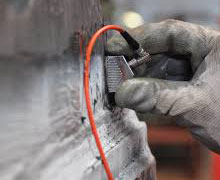|
 UT uses electronic equipment which is bit complex and getting more and more operator friendly every day. Any material which is able to transmit mechanical vibrations can be tested, materials having good rigidity readily fit in to this category. UT detects both linear and non-linear/volumious flaws and their 3D dimensional interpretation and dimensioning is possible. Evaluation is rather difficult and requires very skillful operators and interpreters. The UT instrument converts electrical pulses into mechanical vibrations or waves. UT uses electronic equipment which is bit complex and getting more and more operator friendly every day. Any material which is able to transmit mechanical vibrations can be tested, materials having good rigidity readily fit in to this category. UT detects both linear and non-linear/volumious flaws and their 3D dimensional interpretation and dimensioning is possible. Evaluation is rather difficult and requires very skillful operators and interpreters. The UT instrument converts electrical pulses into mechanical vibrations or waves.
These waves travel across the tested specimen via a transducer and reflect from flaws because of their different acoustic characteristics (impedance). The returning reflected waves are re-converted in to electrical pulses and displayed as signals on a cathode ray tube (CRT). The position and magnitude of these signals indicate the position and size of the flaws.
|